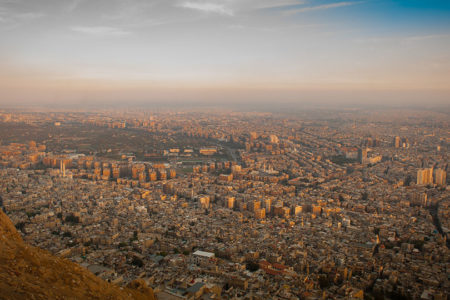Israel’s Quest for Peace
Israel is a unique nation. What other country was crushed by a reigning superpower and its surviving citizens scattered virtually around the globe, only to see their descendants eventually restored to ancient boundaries? What other dispersed people kept its original language alive by using it in religious services, only to see it reemerge as the everyday conduit of communication and commerce? Such may be the stuff of storybooks and screenplays, but not of real life. And yet it is real. Indeed, it is Israel.
Yet the Jewish return to the Promised Land has hardly been easy. Israel was reborn in 1948 amid the billowing flames of war. And the world’s only Jewish state has experienced the trauma of war every decade since then: the Suez Canal conflict of 1956; the intense Six-Day War of 1967; the surprise 1973 Yom Kippur Arab attack; the Israeli incursion into Lebanon in 1982; and finally, Saddam Hussein’s 1991 Scud attacks on Tel Aviv and other urban centers.
Today we are barely into the new decade (and millennium), but already a new war looms on the horizon. Soon after the newest Palestinian uprising began in September 2000, various Arab states reduced or entirely severed fledgling diplomatic ties with beleaguered Israel. Massive anti-Israel demonstrations swept Cairo, Damascus, Baghdad, Amman, Fez, and other Arab cities. The dank smell of war once again scented Middle Eastern skies.
Yet only a couple of years earlier, most political analysts and world leaders spoke of an imminent and inevitable peace taking hold in the region. The Arab world’s main diplomatic and military backer—the Soviet Union—was no more, leaving Israel’s close ally, America, sitting alone atop the new world order. Working closely with European leaders, with full support from the humbled Kremlin, U.S. President Bill Clinton happily embraced clandestine peace talks taking place between Israeli and Palestinian leaders in Norway. The talks led to the preliminary Oslo peace accord signed on the White House lawn in September 1993.
The agreement surprised most Israelis and Palestinians. They had no inkling of the secret negotiations. Among the most surprised were all but a handful of Israeli cabinet members who deliberately had been kept in the dark. The most disturbing aspect to many Israelis was the apparent resuscitation of PLO leader Yasser Arafat, whose terrorist group had attacked hundreds of Israeli targets for almost three decades. Arafat seemed on the verge of being forced into the political wilderness when Israeli leaders Shimon Peres and Yossi Beilen pulled him into the center of the peace process, arguing that no accord could succeed without him.
When details of the preliminary Oslo accord surfaced, the biggest shock to most Israelis was that Prime Minister Yitzhak Rabin had agreed to negotiate the final status of Jerusalem with Arafat. Former President Jimmy Carter had successfully jettisoned the explosive issue of Jerusalem at the 1978 Camp David peace talks between Egypt and Israel. It seemed safely fixed in orbit until the Oslo pact was signed in Washington.
Dashed Hopes
With world leaders hailing Oslo as a major breakthrough, many Israelis dared to hope that the agreement finally signaled the end of the country’s long and difficult quest for peace. If a bitter foe like Arafat could sign a peace agreement, then other Arab leaders eventually would follow, they thought. These optimistic assessments seemed warranted when Jordan’s King Hussein eagerly jumped on the peace train just one year later in 1994. Most Israeli political analysts said the Jewish state’s remaining enemies, especially Syria, now would be forced to leap on board as well, since the peace train was virtually unstoppable. And even if Saddam Hussein of Iraq and several others remained as holdouts, they would become insignificant bystanders as the train rushed inevitably forward.
But Syria did not jump on board. Its crafty dictator, Hafez al-Assad, rebuffed the proposals Clinton and European officials put forward. Assad missed an opportunity to get back most, if not all, of the Golan Heights and missed it again under Rabin’s successor, Shimon Peres. When the more reticent Benjamin Netanyahu was elected prime minister in May 1996, Assad smugly announced that there was no use even trying to make peace with Israel. Indeed, Netanyahu was far less willing to give back the strategic Golan plateau that rises above the Sea of Galilee and northern Galilee panhandle and which supplies much of Israel’s vital fresh water. Still, Netanyahu backed the continuing clandestine American attempts to bridge the gaps dividing Middle East foes.
In the wake of his exposed affair with a White House intern, a disgraced Bill Clinton was more eager than ever to seal a final peace deal. But Netanyahu was not ready to negotiate with Arafat until the Palestinian leader anted up for earlier Israeli land concessions that had given him control of around 90 percent of the Gaza Strip and 40 percent of Judea and Samaria, the former West Bank annexed by Jordan in 1950.
Netanyahu knew Arafat was violating important Oslo commitments. Arafat even had twice the armed security personnel permitted under the preliminary peace pact, and many were members of illegal paramilitary militia forces loosely connected to Arafat’s PLO Fatah faction. Another significant violation Netanyahu emphasized was Arafat’s failure to curb the activities of militant anti-Oslo Muslim groups like Hamas and Islamic Jihad.
For most Israelis, the worst Palestinian Oslo violation was the continued terrorist attacks on hapless Jewish civilians. Arafat and his PLO colleagues had sworn in writing that they recognized Israel’s right to exist within secure borders in the mostly Muslim Middle East and had pledged to fight terror by all means possible.
Few analysts doubted that Netanyahu’s electoral victory was due mainly to the intense wave of Islamic terror attacks in early 1996 that left scores of Israelis dead and wounded. Arafat seemed incapable of, or at least uninterested in, halting the carnage. Netanyahu pointed out that Israel had relinquished tangible assets—land—in exchange for Palestinian promises of peace. That land was not some far-off island or a mere sliver of a vast continental empire. It was territory located just a couple miles from Israel’s capital city, Jerusalem, and a few miles east of the Israeli coastal towns of Netanya, Tel Aviv, Kfar Sava, Hadera, and other urban centers.
Until Arafat kept his end of the bargain and stopped the violent Islamic assaults, Netanyahu refused to hand over any more land to the Palestinian Authority. Under intense international (especially American) pressure, Netanyahu nonetheless agreed to withdraw his troops from most of the Judean town of Hebron, Judaism’s second holiest site on earth. The concession shocked many of Netanyahu’s coalition partners, who ultimately caused the early demise of his government. They warned that armed Palestinians would use the evacuated hills to launch armed attacks on the small Jewish community in the town below—a warning that came true during the newest uprising.
Benjamin Netanyahu was swept out of office prematurely by Ehud Barak’s landslide victory of May 1999. Ironically, Barak won largely due to his opponent’s success in partially quelling the terrorist violence that had plagued the previous Peres and Rabin governments. Actually, the attacks did not subside because Netanyahu took special steps to suppress them but because the Islamic militants and their Iranian and Iraqi backers viewed the peace process they were trying to destroy as dead anyway under Netanyahu.
With the original Oslo architects now back in office, the peace train got rolling again. Lulled to sleep by the relative calm under Netanyahu’s rule, a majority of Israelis were again willing to take serious risks in exchange for Arafat’s promises of peace. They supported Barak’s efforts to negotiate a final-status peace accord with the aging PLO chairman, even when Barak explained it would mean making “painful concessions” to the Palestinians. These probably were to include evacuating the strategic Jordan Valley; abandoning most Israeli settlements in Judea, Samaria, and the Gaza Strip; and even handing over control of parts of Jerusalem to Arafat.
A majority of Israelis also backed Barak’s negotiations with Syria (conducted personally by Bill Clinton) in late 1999 and early 2000, even giving their full, if excruciating, support to the fact that most, if not all, of the beloved Golan Heights would have to be returned to Syrian control. Indeed, Barak offered to give back to Assad all of the high ground over a period of several years, excluding a vital strip along the northeast shore of the Sea of Galilee that Syrian troops captured from Israel during skirmishes before 1967. The Syrian strongman, who would die a few months later, said no to the generous offer, wanting no part of Barak’s deal unless he got back his ill-gotten lakefront property.
Al-Aqsa Uprising
With Barak in tow, an astonished Bill Clinton then turned his negotiating attention to the languishing “Palestinian peace track.” He thought he had secured a real breakthrough when the Israeli leader agreed to meet virtually all of Arafat’s demands at a Camp David summit in July 2000. Barak handed the Palestinians full control of the Gaza Strip and over 95 percent of Judea and Samaria, uprooting most Jewish communities but annexing those in three settlement blocks located just south and east of Jerusalem and around the town of Ariel, northeast of Tel Aviv. Israel also agreed to make up the missing five percent by ceding an equal amount of territory adjacent to Arafat’s zones. Most amazing to many Israelis, the Palestinian leader was to receive full administrative control over Arabs living in eastern Jerusalem and over much of the historic, walled Old City.
To the complete chagrin of Clinton and Barak, Arafat turned down the far-reaching offer, demanding that all Jewish settlements be evacuated and that Palestinian refugees and their offspring be allowed to return to ancestral homes inside Israel proper. Barak rejected the latter demand as a thinly veiled attempt to destroy Israel from within by flooding it with millions of Arabs. He and Clinton said that Israel and the United States were willing to help Arafat absorb the refugees in his emerging state, but the Palestinian leader flatly rejected the offer.
The resulting stalemate quickly turned into the new Palestinian uprising. It was named the Al-Aqsa Intifada, revealing that its main goal is to fulfill Arafat’s frequent pledge to make the revered Temple Mount in “holy Jerusalem” the center of the emerging Palestinian state, “whether Israel likes it or not.”
After months of bitter clashes with Israeli forces that left hundreds of Palestinians dead, Arafat seems no closer to achieving by violence the goal he let slip through his fingers at Camp David. Following a series of hideous suicide terrorist attacks, including two horrendous slaughters (one in Tel Aviv in June and the other in Jerusalem in August), the tense Middle East seems once more headed for war. The only comfort for many conflict-weary Israelis is the certain knowledge that the God of Israel neither slumbers nor sleeps and that He will continue to watch over and build up His special ingathered nation, no matter what Muslim and world leaders say or do.







